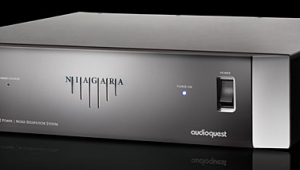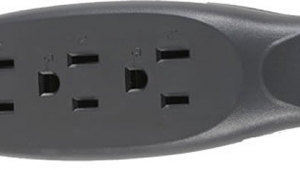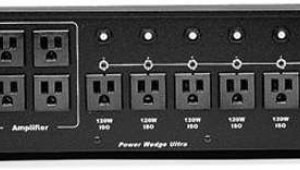| Columns Retired Columns & Blogs |
Cinepro PowerPro 20 Professional Series AC Line Balancer
Any difference that is at all audible must be treated as though it is huge!" John Atkinson declaimed, as Tom Norton and I rolled on the floor laughing. It was a slow day around the Stereophile offices, and the startlingly huge differences that our colleague was describing did strike us as rather piddling—so John began stentorophonically reciting rules from a mythical Guidebook for Audio Reviewers to gales of laughter all around.
Not, I hasten to confess, that I haven't been guilty of the same misdemeanor myself—with the purest motives, of course. We audiophiles tend to get so focused on the fact that there are differences at all that sometimes we, shall I say, exaggerate the scale. Especially in areas where common sense tells us there should be no differences at all.
Take line conditioners. If the electrical standard is good enough for everything else we use, we might be forgiven for asking, why isn't it good enough for hi-fi equipment? Shouldn't all AC current produce good sound, assuming it's up to spec? How much difference can the electricity we're using to run the component make? After all, it's not the signal we're talking about, just the fuel it takes to process it. What could make a line conditioner—or an AC Line Balancer, as Cinepro calls the PowerPro 20—worth eighteen hundred bucks?
Does power corrupt?
Before we can even begin to answer those questions, we need to look at the power coming into our homes. (I'm going to have to ask our international readers to bear with me, as I can only talk about our basic domestic juice here in the US. European and Asian varietals may have nothing in common with our problems or solutions.) Our AC grid has evolved from a technology originally developed to run trolley cars and light bulbs. It was designed primarily to be safe—in fact, back when Tesla's and Westinghouse's AC system was battling Edison's DC scheme, the public was primarily concerned with which was safer. AC is also more convenient, at least from the power company's point of view, since transformers can step the voltage up for long-distance transmission through thin wires. But the alternating current power system wasn't designed to be particularly quiet, mostly because it evolved long before equipment sensitive to electromagnetic interference (EMI) existed.
The US standard uses a three-wire distribution system: a ground; a neutral, which is tied to ground; and a "hot" 120V wire. This unbalanced system is prone to noise pickup due to the fact that neutral is never exactly at true ground potential. And that's not even considering radio-frequency interference (RFI) transmission through electrical lines by computers and digital electronics. So, if the electrical standard is a system that is inherently prone to noise, and if modern life has further eroded its quality, how do we get around reality?
Simple, says Cinepro—transform it. The PowerPro 20 uses a huge (2.5kVA) center-tapped toroidal isolation transformer. Instead of the conventional hot 120V and neutral 0V lines, it employs balanced AC—two 60V lines of opposite phase, so the difference between them is 120V. This eliminates ground currents and the potential for hum, says Cinepro.
Balanced power is recognized by the National Electrical Code (Article 530) for technical power applications—meaning for electronic equipment only, but not for lighting. But if you're the nervous type, the PowerPro 20 provides additional insurance by incorporating GFI (ground fault interrupter) circuitry for "absolute safety."
Cinepro cites the typical noise reduction as 15–20dB. The PowerPro 20 also incorporates filtration for incoming RFI and protects against line spikes and lightning (up to 6500A, they claim). In addition, it monitors the incoming line voltage and warns—by way of an LED bargraph on the faceplate—of very low or very high voltage. Line voltages between 90 and 130V are considered normal, but get between 80 and 90V, or 130 and 140V, and the display will start blinking. Voltages below 80V or above 140V cause protective shutdown. The unit provides additional shielding, including a Faraday shield in the main transformer—they don't say why, but it sounds like they've built the thing on belt-and-suspenders principles.
I want to see the bright lights tonight
The PowerPro 20 is heftier than many power amplifiers. It weighs 75 lbs, which means you won't want to move it a lot—at least I didn't, and I lift weights for fun. Its rack faceplate and hefty handles make it look like a power amp, too. The faceplate has 20 small LEDs arranged in a horizontal line on the right-hand side—these are the AC line voltage display. Voltages from 90 to 128V are represented. From 110 to 120V, green LEDs are used; 106V, 108V, 122V, and 124V are represented by amber LEDS; everything else glows red. There is also a two-color LED outlet status indicator (green for go and red for off, of course), and a red LED to indicate when the unit is in Voltage Protect mode. There's also a large blue power switch. Since the unit is heavy and designed to fit into a rack, I think it's extremely thoughtful of Cinepro to also include a double outlet on the front panel—this made it extremely simple to plug in additional units that weren't going to reside in my system for long. (Otherwise, I'd have been forced to crawl on my belly like a reptile, trying to find a free outlet on the back by feel. Not fun.)
- Log in or register to post comments

































